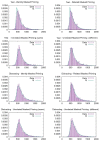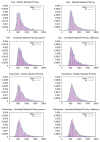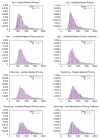Word and Face Recognition Processing Based on Response Times and Ex-Gaussian Components
- PMID: 34066797
- PMCID: PMC8151452
- DOI: 10.3390/e23050580
Word and Face Recognition Processing Based on Response Times and Ex-Gaussian Components
Abstract
The face is a fundamental feature of our identity. In humans, the existence of specialized processing modules for faces is now widely accepted. However, identifying the processes involved for proper names is more problematic. The aim of the present study is to examine which of the two treatments is produced earlier and whether the social abilities are influent. We selected 100 university students divided into two groups: Spanish and USA students. They had to recognize famous faces or names by using a masked priming task. An analysis of variance about the reaction times (RT) was used to determine whether significant differences could be observed in word or face recognition and between the Spanish or USA group. Additionally, and to examine the role of outliers, the Gaussian distribution has been modified exponentially. Famous faces were recognized faster than names, and differences were observed between Spanish and North American participants, but not for unknown distracting faces. The current results suggest that response times to face processing might be faster than name recognition, which supports the idea of differences in processing nature.
Keywords: celebrities; ex-Gaussian fit; face recognition; reaction time; word recognition.
Conflict of interest statement
The authors declare no conflict of interest.
Figures








Similar articles
-
Identification of famous faces and famous names in early Alzheimer's disease. Relationship to anterograde episodic and general semantic memory.Brain. 1996 Feb;119 ( Pt 1):111-28. doi: 10.1093/brain/119.1.111. Brain. 1996. PMID: 8624675
-
The neural systems sustaining face and proper-name processing.Brain. 1998 Nov;121 (Pt 11):2103-18. doi: 10.1093/brain/121.11.2103. Brain. 1998. PMID: 9827770
-
Face shape and face identity processing in behavioral variant fronto-temporal dementia: A specific deficit for familiarity and name recognition of famous faces.Neuroimage Clin. 2016 Mar 10;11:368-377. doi: 10.1016/j.nicl.2016.03.001. eCollection 2016. Neuroimage Clin. 2016. PMID: 27298765 Free PMC article.
-
Are faces special in Alzheimer's disease? Cognitive conceptualisation, neural correlates, and diagnostic relevance of impaired memory for faces and names.Cortex. 2007 Oct;43(7):898-906. doi: 10.1016/s0010-9452(08)70689-0. Cortex. 2007. PMID: 17941348 Review.
-
Laterality effects in normal subjects' recognition of familiar faces, voices and names. Perceptual and representational components.Neuropsychologia. 2013 Jun;51(7):1151-60. doi: 10.1016/j.neuropsychologia.2013.03.009. Epub 2013 Mar 28. Neuropsychologia. 2013. PMID: 23542500 Review.
Cited by
-
Correctness and response time distributions in the MemTrax continuous recognition task: Analysis of strategies and a reverse-exponential model.Front Aging Neurosci. 2022 Nov 3;14:1005298. doi: 10.3389/fnagi.2022.1005298. eCollection 2022. Front Aging Neurosci. 2022. PMID: 36437986 Free PMC article.
-
The Effect of Corrective Feedback in Basic Cognitive Tasks: A Study in Early Childhood.Children (Basel). 2022 Jan 23;9(2):145. doi: 10.3390/children9020145. Children (Basel). 2022. PMID: 35204866 Free PMC article.
References
-
- Berg T.L., Berg A.C., Edwards J., Maire M., White R., Teh Y.-W., Learned-Miller E., Forsyth D.A. Names and Faces in the News; Proceedings of the 2004 IEEE Computer Society Conference on Computer Vision and Pattern Recognition, 2004. CVPR 2004; Washington, DC, USA. 27 June–2 July 2004; pp. 848–854.
-
- Crossman E.R.F.W. Entropy and Choice Time: The Effect of Frequency Unbalance on Choice-Response. Q. J. Exp. Psychol. 1953;5:41–51. doi: 10.1080/17470215308416625. - DOI
LinkOut - more resources
Full Text Sources

